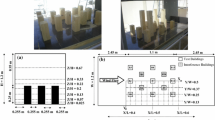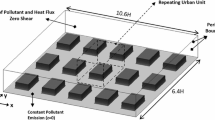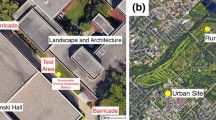Abstract
Wind and temperature measurements from within and above a deep urban canyon (height/width = 2.1) were used to examine the thermal structure of air within the canyon, exchange of heat with the overlying atmosphere, and the possible impacts of surface heating on within-canyon air flow. Measurements were made over a range of seasons and primarily analysed for sunny days. This allowed the study of temperature differences between opposing canyon walls and between wall and air of more than 15°C in summer. The wall temperature patterns follow those of incoming solar radiation loading with a secondary daytime effect from the longwave exchange between the walls. In winter, the canyon walls receive little direct solar radiation, and temperature differences are largely due to anthropogenic heating of the building interiors. Cool air from aloft and heated air from canyon walls is shown to circulate within the canyon under cross-canyon flow. Roofs and some portions of walls heat up rapidly on clear days and have a large influence on heat fluxes and the temperature field. The magnitude and direction of the measured turbulent heat flux also depend strongly on the direction of flow relative to surface heating. However, these spatial differences are smoothed by the shear layer at the canyon top. Buoyancy effects from the heated walls were not seen to have as large an impact on the measured flow field as has been shown in numerical experiments. At night canyon walls are shown to be the source of positive sensible heat fluxes. The measurements show that materials and their location, as well as geometry, play a role in regulating the heat exchange between the urban surface and atmosphere.
Similar content being viewed by others
References
Aida M (1982) Urban albedo as a function of the urban structure – a model experiment (Part I). Boundary-Layer Meteorol 23:405–413
Aida M, Gotoh K (1982) Urban albedo as a function of the urban structure – a two-dimensional numerical simulation (Part II). Boundary-Layer Meteorol 23:415–424
Arnfield AJ (1982) An approach to the estimation of the surface radiative properties and radiation budgets of cities. Phys Geogr 3:97–122
Arnfield AJ (2003) Two decades of urban climate research: a review of turbulence, exchanges of energy and water, and the urban heat island. Int J Climatol 23:1–26
Baik J-J, Kim J-J (1999) A numerical study of flow and pollutant dispersion characteristics in urban street canyons. J Appl Meteorol 38:1576–1589
Best MJ (2005) Representing urban areas within operational numerical weather prediction models. Boundary-Layer Meteorol 114:91–109
Christen A, Vogt R (2004) Energy and radiation balance of a central European city. Int J Climatol 24:1394–1421
Dabbert WF, Ludwig FL, Johnson WB Jr (1973) Validation and applications of an urban diffusion model for vehicular pollutants. Atmos Environ 7:603–618
Eliasson I, Offerle B, Grimmond CSB, Lindqvist S (2005) Wind fields and turbulence statistics in an urban street canyon. Atmos Environ 40:1–16. DOI: 10.1016/j.atmosenv.2005.03.031
Grimmond CSB, Salmond JA, Oke TR, Offerle B, Lemonsu A (2004) Flux and turbulence measurements at a dense urban site in Marseille: heat, mass (water, carbon dioxide) and momentum. J Geophys Res Atmos 109(D24101):1–19. DOI: 10.1029/2004JD004936
Harman IN, Best MJ, Belcher SE (2004a) Radiative exchange in an urban street canyon. Boundary-Layer Meteorol 110:301–316
Harman IN, Barlow JF, Belcher SE (2004b) Scalar fluxes from urban street canyons. Part II: model. Boundary-Layer Meteorol 113:387–409
Kanda M, Moriwaki R, Kimoto Y (2005) Temperature profiles within and above an urban canopy. Boundary-Layer Meteorol 115:499–506. DOI: 10.1007/s10546-004-5644-5
Kim J-J, Baik J-J (2001) Urban street-canyon flows with bottom heating. Atmos Environ 35:3395–3404
Kondo A, Ueno M, Kaga A, Yamaguchi K (2001) The influence of urban canopy configuration on urban albedo. Boundary-Layer Meteorol 100:225–242
Kovar-Panskus A, Moulinneuf L, Savory E, Abdelqari A, Sini J-F, Rosant J-M, Robins A, Toy N (2002) A wind tunnel investigation of the influence of solar-induced wall-heating on the flow regime within a simulated urban street canyon. Water, Air, Soil Poll: Focus 2:555–571
Kusaka H, Kondo H, Kikegawa Y, Kimura F (2001) A simple single-layer urban canopy model for atmospheric models: comparison with multi-layer and slab models. Boundary-Layer Meteorol 101:329–358
Louka P, Vachon G, Sini J-F, Mestayer PG, Rosant J-M (2002) Thermal effects on the airflow in a street canyon – Nantes’99 experimental results and model simulations. Water, Air, Soil Poll: Focus 2:351–364
Martilli A, Clappier A, Rotach MW (2002) An urban surface exchange parameterisation for mesoscale models. Boundary-Layer Meteorol 104:261–304
Masson V (2000) A physically-based scheme for the urban energy balance in atmospheric models. Boundary-Layer Meteorol 94:357–397
Masson V, Grimmond CSB, Oke TR (2002) Evaluation of the town energy balance (TEB) scheme with direct measurements from dry districts in two cities. J Appl Meteorol 41:1011–1026
Nakamura Y, Oke TR (1988) Wind, temperature and stability conditions in an east-west oriented urban canyon. Atmos Environ 22:2691–2700
Nunez M, Oke TR (1977) The energy balance of an urban canyon. J Appl Meteorol 16:11–19
Offerle B, Grimmond CSB, Fortuniak K, Kłysik K, Oke TR (2006) Temporal variations in heat fluxes over a central European city centre. Theor Appl Climatol 84: 103–116
Oke TR (1987) Boundary layer climates. Routledge, 435 pp
Sailor DJ, Fan H (2002) Modeling the diurnal variability of effective albedo for cities. Atmos Environ 36:713–725
Salmond JA, Oke TR, Grimmond CSB, Roberts S, Offerle B (2005) Venting of heat and carbon dioxide from urban canyons at night. J Appl Meteorol 44:1180–1194
Schmid HP (2002) Footprint modeling for vegetation atmosphere exchange studies: a review and perspective. Agric For Meteorol 113:159–184
Schotanus P, Nieuwstadt FTM, DeBruin HAR (1983) Temperature measurement with a sonic anemometer and its application to heat and moisture fluctuations. Boundary-Layer Meteorol 26:81–93
Sini J, Anquetin S, Mestayer P (1996) Pollutant dispersion and thermal effects in urban street canyons. Atmos Environ 30:2659–2677
Vachon G, Rosant J-M, Mestayer P, Sini J-F (1999) Measurements of dynamic and thermal field in a street canyon, URBCAP Nantes 99. In: Proceedings of the 6th international conference on harmonisation within atmospheric dispersion modelling, Rouen, France, October 11–14, 12 pp
Vardoulakis S, Fisher BEA, Pericleous K, Gonzalez-Flesca N (2003) Modelling air quality in street canyons: a review. Atmos Environ 37:155–182
Voogt JA, Grimmond CSB (2000) Modeling surface sensible heat flux using surface radiative temperatures in a simple urban area. J Appl Meteorol 39:1679–1699
Voogt JA, Oke TR (1998) Effects of urban surface geometry on remotely-sensed surface temperature. Int J Remote Sens 19:895–920
Author information
Authors and Affiliations
Corresponding author
Rights and permissions
About this article
Cite this article
Offerle, B., Eliasson, I., Grimmond, C.S.B. et al. Surface heating in relation to air temperature, wind and turbulence in an urban street canyon. Boundary-Layer Meteorol 122, 273–292 (2007). https://doi.org/10.1007/s10546-006-9099-8
Received:
Accepted:
Published:
Issue Date:
DOI: https://doi.org/10.1007/s10546-006-9099-8




